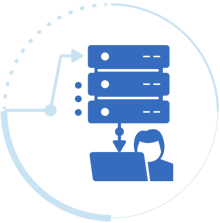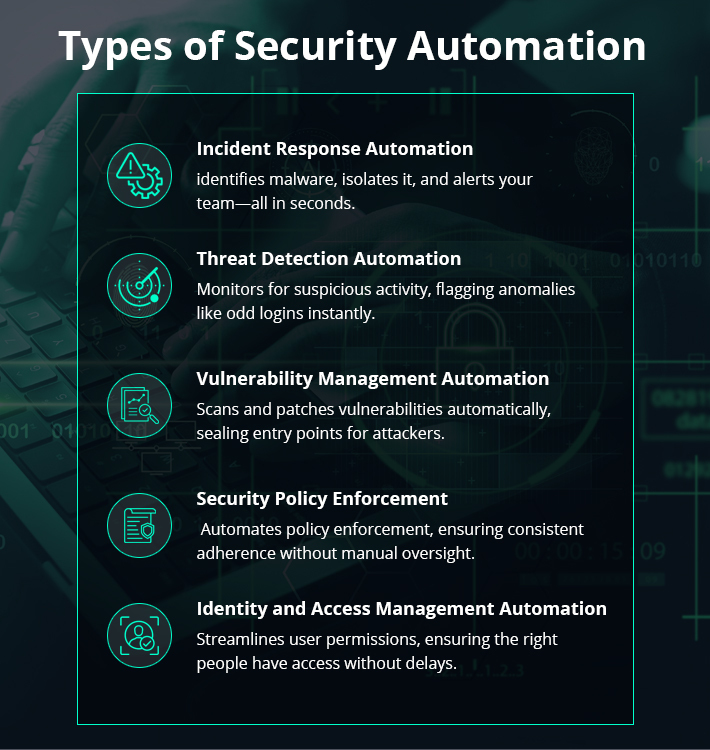Last Updated on December 17, 2024 by Deepanshu Sharma

What is Security Automation?
Security automation means the use of specialized tools and software that can perform security activities autonomously, eliminating the need for someone to manually handle each step. Whether it’s identifying threats, responding to incidents, or enforcing security regulations, automation makes these operations faster and more efficient than if humans did everything.
Consider it as having a squad of virtual security guards who never sleep, constantly monitoring for suspicious activities and acting fast when something goes wrong. That is essentially what security automation accomplishes. It does not imply that you replace your security staff, but rather that you provide them with a powerful tool that allows them to perform more efficiently and effectively. Instead of becoming mired down in everyday duties, your team can focus on the larger picture.
The Need for Security Automation
The demand for security automation has never been higher. Organizations are having difficulty keeping up with the increasing frequency and complexity of cyberattacks. Human teams are frequently overwhelmed by the sheer volume of data and security warnings, many of which prove to be false alarms. It can be difficult to locate the true hazards among thousands of notifications.
Automating security operations helps to reduce hassle and handle routine tasks more efficiently. It’s not just about efficiency, either. Speed is essential in cybersecurity. The sooner you respond to a possible threat, the better your chances of minimizing it before it does significant harm. Security automation systems are meant to respond in real-time, which is critical in high-pressure circumstances where every second counts.
Benefits of Security Automation
Implementing security automation comes with several significant benefits:
Swift Response
Cyberattacks move fast. So should your defense. Automation ensures immediate responses, shutting down threats as soon as they emerge. No waiting around for a human to notice—it’s done in seconds.
Fewer Mistakes
We all make errors, especially when there’s a lot on our plate. But machines? Not so much. By automating processes like monitoring and patching, you reduce the risk of human mistakes leading to security gaps.
Saving on Costs
Automation might seem expensive upfront, but think about it. Less manpower for repetitive tasks, fewer chances of breaches—long-term, it saves you both time and money.
Scaling with Ease
As your business grows, so do your security needs. Automated systems can scale up without needing to hire a bunch of new people. More systems, more users, no extra stress.
Better Focus
With mundane tasks out of the way, your security team can focus on bigger, more strategic initiatives. They’re not stuck sifting through endless alerts or managing patches—they can focus on protecting your organization at a higher level.
Consistency
Automated systems don’t take breaks, don’t have bad days, and definitely don’t get distracted. This ensures consistent enforcement of security policies across your entire organization, 24/7.
Security Automation Implementation Best Practices
Now, implementing automation isn’t a magic fix. You’ve got to approach it smartly. Jumping in without a plan? Yes, that could backfire.
Prioritize Critical Areas
Don’t try to automate everything at once. Start by focusing on high-impact areas that are both time-consuming and prone to errors, like incident response. Once you’ve got those under control, you can expand to other areas.
Engage Your Team
Your security team is on the front lines, so it’s essential to involve them from day one. Their input can help tailor automation to your organization’s specific needs, making it more effective overall.
Set Clear Objectives
What do you want to achieve with automation? Reduced response times? Fewer false positives? Make sure you define measurable goals so you can track whether automation is making a difference.
Keep Testing and Tweaking
Automation isn’t “set it and forget it.” Regular testing and tweaking are key to ensuring that your systems are working optimally. Don’t assume everything will always go according to plan—keep checking and adjusting as needed.

Types of Security Automation
There’s more than one type of security automation, and each serves its own purpose.

Incident Response Automation
Whenever a malware makes its way into your network. With incident response automation, the system identifies the threat, isolates it, and notifies the right people in seconds. No time wasted, no damage done.
Threat Detection Automation
Think of this as a 24/7 surveillance system. Automated threat detection constantly monitors your network, flagging anything unusual. Whether it’s a strange login or an abnormal data transfer, the system catches it instantly.
Vulnerability Management Automation
Vulnerabilities are inevitable, but automation helps minimize their impact. Automated vulnerability management can scan your systems regularly and apply patches without delay, closing potential entry points for attackers.
Security Policy Enforcement
Enforcing security policies manually is a hassle, especially in large organizations. Automation takes care of that for you, ensuring that rules are consistently followed without requiring constant oversight.
Identity and Access Management (IAM) Automation
Managing access rights manually can quickly become a nightmare, especially as your workforce grows. With IAM automation, you can ensure that employees have the right level of access to the systems they need without delays or errors.
Common Use Cases of Security Automation
Defending Against Phishing
Phishing remains one of the most prevalent forms of attack. Security automation can detect and quarantine suspicious emails before they even reach an employee’s inbox, drastically reducing the risk of someone falling for a scam.
Managing Patches
Manually applying patches across an entire network? That’s a time sink. Automation ensures that patches are applied as soon as they’re available, keeping your systems secure without the hassle.
Data Loss Prevention (DLP)
Automated DLP systems monitor sensitive data flow and prevent unauthorized transfers. If something suspicious occurs, the system blocks the transfer and alerts the security team instantly.
SIEM Automation
SIEM (Security Information and Event Management) systems collect data from across your network, providing valuable insights. Automating this process helps spot potential threats faster and more efficiently than manual oversight.
Ensuring Compliance
Staying compliant with regulations like GDPR or HIPAA is time-consuming. Compliance automation generates reports, tracks incidents, and ensures that security policies are consistently enforced across the organization.
Conclusion
Security automation is critical for staying ahead of modern cyber threats. By completing regular tasks quickly and effectively, security teams may focus on significant concerns while lowering human error and response times. While automation cannot replace human expertise, it is an effective tool for increasing productivity and improving your overall security posture. Adopting it means you’re not just responding to threats, but actively protecting against them.
If you want to learn more about how Lepide can help, feel free to schedule a demo with one of our engineers today.


 Group Policy Examples and Settings for Effective Administration
Group Policy Examples and Settings for Effective Administration 15 Most Common Types of Cyber Attack and How to Prevent Them
15 Most Common Types of Cyber Attack and How to Prevent Them Why the AD Account Keeps Getting Locked Out Frequently and How to Resolve It
Why the AD Account Keeps Getting Locked Out Frequently and How to Resolve It
